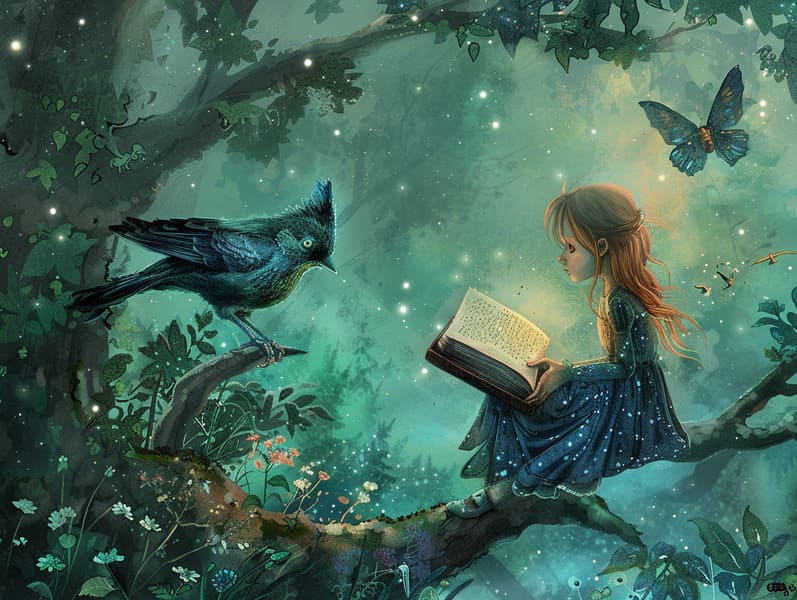
Traditional fairy tales have long histories. These narratives have been spoken from one generation to the next ages before they were ever written down. They originated from a variety of societies, including Eastern traditions. They were initially shared among mature audiences, often carrying themes and messages related to the societal norms and beliefs of the time.
The famous Grimm duo, Jacob and Wilhelm (the Grimm brothers), were among the first to compile and release many of these beloved fairy tales. Their collection, "Grimm's Fairy Tales," included stories like "The Little Glass Slipper," "Hansel and Gretel," and "The True Story of Snow White," which have since become cornerstones in the world of famous fairy tales. Similarly, Andersen's delightful narratives, such as "The Mermaid," and "The Duckling's Story," have touched hearts worldwide, securing their place in the pantheon of beloved fairy tales.
Though they are centuries old, fairy tales remain as important as ever, especially as bedtime stories for kids. These magical stories are now available in multiple formats, including gorgeously illustrated books, delightful animations, and internet fairy tales.
Their continued relevance can be attributed to several fascinating points:
Valuable Lessons: Timeless fairy tales often present important moral lessons. Fairy tales like "The Boy Who Cried Wolf" teach the benefit of sincerity, while "The Tortoise and the Hare" show the virtues of determination and humbleness. These tales offer children clear distinctions between moral and immoral, shaping their moral compass in a gentle yet significant way.
Empathy and Awareness: Classic fairy tales frequently feature protagonists facing problems and hurdles, provoking children to connect with their struggles and champion their triumphs. For instance, "Beauty and Her Beast" shows us the significance of valuing inner qualities to acknowledge the true nature of a soul, enhancing empathy and knowledge.
Cultural Knowledge: Many timeless fairy tales are imbued with the cultural contexts from which they blossomed. Engaging with these fairy tales can provide delightful insights into different cultures, encouraging a sense of cultural awareness and appreciation.
Creativity and Fantasy: The whimsical elements in traditional fairy tales—enchanted objects—fire up children’s imaginations. These stories carry readers to fantasy realms, awakening inventive ideas and a sense of curiosity that endures a lifetime.
Traditional fairy tales are not only delightful but also illuminating. They serve as fascinating tools in building various intellectual and emotional capacities in little ones. When traditional fairy tales are voiced, they develop verbal development by bringing new linguistic elements and detailed sentence structures. This practice also advances listening skills and concentration, as little ones follow the story, eager to see what happens next.
Furthermore, deliberating the themes and characters of classic fairy tales can sharpen intellectual skills and problem-solving abilities. Kids are educated to discern patterns, anticipate outcomes, and figure out cause and effect. These discussions also aid children express their thoughts and feelings, strengthening their emotional intelligence.
In today’s cyber age, the abundance of digital storybooks has made these stories more acquirable than ever. Internet resources and software provide huge assortments of popular fairy tales that can be perused or played anytime, anywhere. Fairy tales narrated are particularly in demand, featuring an interactive method for kids to immerse in these bewitching tales. Read-aloud stories and read-aloud videos transport characters and settings to life, often supported by whimsical soundtracks and harmonies that raise the tale journey.
The enduring charm of classic fairy tales lies in their ability to adjust to changing times while keeping their central values. Contemporary reinterpretations of these tales often feature more inclusive figures and modern settings, making them pertinent to today’s audience. However, the essential messages of gallantry, warmth, and lawfulness remain unchanged, continuing to affect children of all ages.
Traditional fairy tales also offer a sense of calm and knowability. They extend a orderly narrative with a straightforward beginning, middle, and end, often ending with the finalization of conflicts and the triumph of virtue over vice. This uniformity can be solacing for kids, providing a sense of steadfastness in an fluid world.
Ancient fairy tales continue to fascinate and enlighten new generations, maintaining their spell and meaningfulness in modern society. As nighttime stories for kids, they grant access to a perfect blend of fantasy and learning, boosting moral values, empathy, and creativity. The prevalence of online storybooks and the well-received status of fairy tales voiced guarantee that these old stories remain within reach to new generations.
By holding onto and recounting these fairy tales, we continue to venerate the rich tapestry of folklore and cultural heritage. Whether you are accessing a colorful picture book, accessing a digital collection, or listening via an audiobook, the grandeur of timeless fairy tales is always within reach. These narratives reveal of the everlasting effect of tales and its ability to connect us across eras and regions.
Regardless if you find it here are exploring a vividly illustrated book, accessing a cyber library, or playing an narrated book, the appeal of old fairy tales is always within reach.
These tales show us of the unwavering effect of tales and its ability to bond us across centuries and lands, creating a bond that delights and instructs alike.